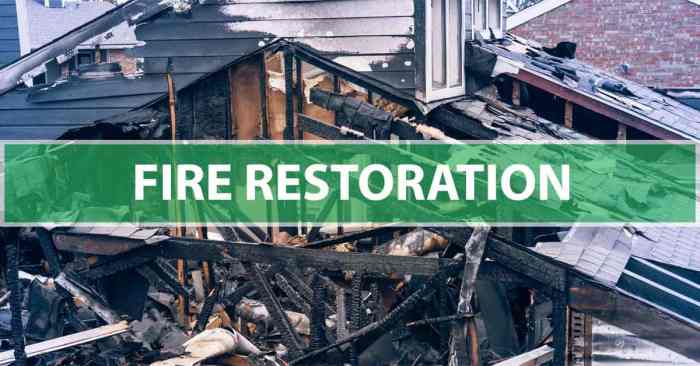Fire damage restoration services set the stage for this enthralling narrative, offering readers a glimpse into a story that is rich in detail and brimming with originality from the outset. The process of restoring properties after a fire is a crucial aspect that requires professional expertise and attention to detail.
As we delve deeper into the intricacies of fire damage restoration services, we uncover the essential steps involved in assessing, cleaning, repairing, and reconstructing properties affected by fire incidents.
Overview of Fire Damage Restoration Services
Fire damage restoration services involve the process of repairing and restoring properties that have been affected by fire. It is crucial to seek professional restoration services after a fire to ensure the safety of the property and its occupants, as well as to prevent further damage.Common Tasks Involved in Fire Damage Restoration
- Assessment of the damage: Professionals will assess the extent of the fire damage to determine the necessary steps for restoration.
- Water damage cleanup: Water used to extinguish the fire can cause secondary damage, so professionals will remove excess water and dry the affected area.
- Soot and smoke removal: Soot and smoke residue can be hazardous and difficult to clean, requiring specialized equipment and techniques.
- Odor removal: Lingering smoke odors can be eliminated through thorough cleaning and deodorization processes.
- Structural repairs: Restoration professionals will repair and rebuild damaged structures to ensure the property is safe and structurally sound.
Assessment and Inspection
When it comes to fire damage restoration services, the assessment and inspection phase is crucial in determining the extent of the damage and the best course of action to take.Process of Assessing Fire Damage
- Professionals will thoroughly inspect the property to assess the damage caused by the fire, smoke, and water used to extinguish the fire.
- They will document all visible damage, including structural issues, soot residue, and water damage.
- Specialized equipment may be used to detect hidden damage, such as moisture meters and thermal cameras.
Importance of Thorough Inspection
- A comprehensive inspection helps in identifying all areas affected by the fire, ensuring that no damage goes unnoticed.
- It allows professionals to create a detailed plan for restoration, addressing all aspects of the damage effectively.
- Identifying hidden damage early on can prevent further issues from arising during the restoration process.
Determining the Best Course of Action
- Based on the assessment findings, professionals will prioritize the restoration tasks, starting with the most critical areas.
- They will develop a customized restoration plan tailored to the specific needs of the property and the extent of the damage.
- Factors such as safety hazards, structural integrity, and the presence of hazardous materials will influence the decision-making process.
Cleaning and Deodorization
When it comes to fire damage restoration, cleaning and deodorization are crucial steps in returning a property to its pre-fire condition. Cleaning involves the removal of soot, smoke residue, and other contaminants left behind by the fire, while deodorization focuses on eliminating smoke odors that can linger long after the flames have been extinguished.Methods for Cleaning
- Dry Cleaning: This method involves using dry sponges or cleaning cloths to remove loose soot and smoke residue from surfaces.
- Wet Cleaning: Wet cleaning is used on surfaces that can withstand moisture, such as walls and countertops, using specialized cleaning solutions to remove stubborn soot and residue.
- HEPA Vacuuming: High-efficiency particulate air (HEPA) vacuums are used to remove fine particles and contaminants from surfaces and the air.
Deodorization Techniques
- Ozone Treatment: Ozone generators are used to break down smoke molecules and eliminate odors by oxidizing them.
- Thermal Fogging: This technique involves using a deodorizing fog to penetrate porous materials and neutralize smoke odors.
- Air Scrubbers: These devices help to clean and purify the air by capturing particles and odors through filters.
Cleaning Equipment and Products
- Sponges and Cleaning Cloths: Used for dry cleaning surfaces and removing loose soot.
- Specialized Cleaning Solutions: Formulated to effectively remove stubborn soot and smoke residue from various surfaces.
- HEPA Vacuums: Essential for removing fine particles and contaminants from surfaces and the air.
- Ozone Generators: Designed to break down smoke molecules and eliminate odors through oxidation.
- Thermal Foggers: Used to penetrate porous materials with a deodorizing fog to neutralize smoke odors.
Structural Repair and Reconstruction
When it comes to fire damage restoration, structural repair and reconstruction are crucial steps in returning a property to its pre-fire condition. These processes involve repairing and rebuilding the damaged structures to ensure the safety and integrity of the building.Steps in Structural Repair and Reconstruction
- Assessment of structural damage: Professionals assess the extent of the damage to determine the scope of repair and reconstruction needed.
- Removal of damaged materials: Damaged materials such as charred wood, drywall, and insulation are removed to prepare for reconstruction.
- Rebuilding and repair: Skilled contractors rebuild and repair the damaged structures using quality materials to restore the property.
- Finishing touches: Once the structural repairs are complete, finishing touches such as painting, flooring, and trim work are done to complete the restoration process.
Importance of Structural Integrity
Structural integrity is vital in the restoration process as it ensures the safety and stability of the building. Weak or compromised structures can pose a serious risk to occupants and can lead to further damage if not properly addressed.Ensuring Safety during Repair and Reconstruction
- Compliance with building codes: Professionals ensure that all repair and reconstruction work meets building codes and safety regulations to guarantee the structural integrity of the property.
- Use of proper equipment: Skilled workers use specialized equipment and tools to safely conduct repair and reconstruction work, minimizing risks during the process.
- Safety protocols: Strict safety protocols are followed during repair and reconstruction to protect workers and occupants from potential hazards associated with the restoration work.















